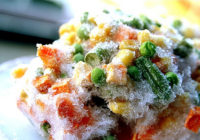
With the leaves changing color and the air getting colder it means it’s that time of the year again. The local farmers markets and farm stands are in full flourish with this seasons harvest. Ripe fruit such as Apples, Peaches, Pears, Nectarines and Plumbs can be found in abundance next to a variety of fresh Fall vegetables. But what makes farmers markets so much better than your local grocery store?
Have you ever wondered why you can get bananas and strawberries in the middle of winter?

This is because the vegetables and fruit in your local supermarket have been either frozen or picked unripened and shipped hundreds of miles from where they originated (often South America, New Zealand, and/or southern United States). During shipment produce is stored in containers full of gases that preserve and ripen them during the transfer. See a neat video about this!
But wait–if they are picked unripened, why are the fruit and vegetables at the grocery store so big, as if they were allowed a full season to grow?

Many of the fruits and veggies available in supermarkets these days have been genetically modified to be bigger and brighter. Large scale farms have taken Gregor Mendel’s concept of genetic inheritance to a whole new level. Instead of simply planting seeds from the best of this years harvest next year, large scale, industrial farms have hired teams of scientists to create super produce that is bigger, juicer and more colorful then anything else out there. Because this is a very new science–GMO foods only started being available in the past decade–the long term effects of these genetically altered super foods to the human body and the environment is unknown.
I don’t care if I eat a mutated tomato if it’s cheap!
That is a reasonable standpoint; most families are ultimately going to go with the more affordable food options. But is super market produce really more affordable? Transportation, packaging and storage play key roles in the cost of imported produce, as well as the final markup by the grocery store to create a profit a small profit for themselves all add to the increasingly high cost of supermarket produce. Local farms, farmers markets, and farm stands may carry a smaller selection, but their produce has generally been grown locally (if not on that very farm), thus greatly reducing transportation costs. They can only offer what is available in season, but often it has picked been picked that very day, so it is guaranteed fresh. Farmers may want to make use of new Agricultural Buildings to store machinery/vehicles and process their produce before heading to market. At farmers markets a majority of the time you are also dealing directly with the person who grew the product. This allows you to occasionally get special deals if you continually purchase from them; reducing the overall cost even more. At the end of the day, local fruit and vegetables are actually a bit cheaper, as well as a bit more delicious than store bought produce.
So the next time you go to a supermarket, just remember: you could be buying cheaper, healthier, fresher LOCAL produce from your local farmers market. Which could be just down the street.
For locations and times of your nearest farmers market check out Farmfresh.org











